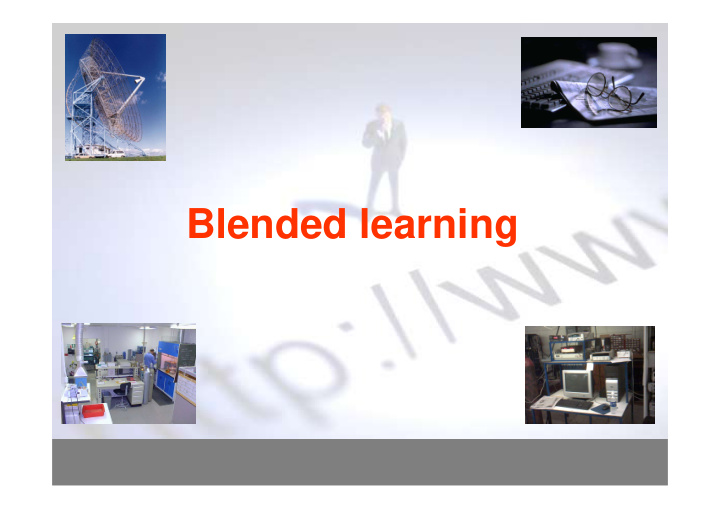



Blended learning
Blended learning Introduced in the technology of education since 2001 • A learning programme where more than one delivery mode is being used • Objectives - To optimize the learning and cost balance - To improve the quality of the learning experience - To increase the availability and accessibility of learning What constitutes a blend? A blend involves a strategy which includes the selection of the delivery the following: - Learning objects - Learning activities - Learning tasks - Teaching and learning methods - Learning strategies - Learning materials - Formative and Summative Assessment - Information - Study skills
What is involved? • Online and offline (i.e. computer) working • Multimedia and other materials & tools • Tasks and activities - planned activities • Group and Individual working • Flexibility - self directed, self paced • Learner - cultured approach • Tutor and facilitator - manager • Constructive approach to teaching • Real life skills - situated in context • Structured and unstructured learning • Simulation in protected environments
The Blend: what is and it is not • Initially BL was considered simply using e-learning methods within a traditional delivery scheme /this is not a Blend/ • A Blend is the optimal mix of learning methods for a given situation • A random mix of on- and off-line objects, tasks and activities is not real Blend • BL is aimed to facilitate the widest possible impact of a learning experience, using a wide range of tools and methods: • Blend attends to individual style
The way to get the right blend • Blend creation is an evolutionary process • The blend objectives are to ensure as the best as possible: • Attention Learning objectives • Engagement requirements Designing blend • Commitment Evaluation • Relevance Learner • Confidence • Motivation • Satisfaction • Support Implementation • These should influence all stages, especially requirements and evaluation
Components of blended learning a. Six off-line components b. Six online components • Workplace learning • Online learning content • Face-to face tutoring, • E-tutoring, e-coaching or e- coaching or mentoring mentoring • Classroom • Online collaborative learning • Distributable electronic media • The web • Broadcast media • Mobile learning Blended learning levels of complexity Level 1 – Component Characteristics • Take separate delivery channels • Components are 2 3 Simple blend 1 + + separate in content • A single component can component function effectively
Level 2 – Integrated Component 1 Characteristics Component 2 • Direct design features • Style Single unified • Cross references whole • Links and dependencies Component 3 Level 3 – Collaborative Characteristics • Face-to-face • Electronic tutoring Cohesion of • Coaching or mentoring components • Collaborative facilities Collaborative environment
Level 4 – Expansive Characteristics • Use of on-line resources Extended Beyond • Use of off-line resources component Traditional techniques Collaborative environment Off-line component groups Distributab Face-to- Workplace Distributable le Broadcast face Classroom learning print media electronic media tutoring media Manager as Books Lecture/Presen Tutoring developer Magazines tation Audio Learning on job Coaching Newspapers Tutorials cassettes TV projects Mentorin Workbooks Workshops Audio CD Radio Apprenticeship g Keeping a Seminars Videotape Interactive 360 Shadowing journal Role play CD-ROM TV Placements degree Review/Learn Simultaneous DVD Site visits Feedback ing Congresses Logs
Online component group E-tutoring, On line Online Mobile Online learning e-couching collaborative knowledge The web learnin content or e- learning management g mentoring Simple learning Asynchronous resources (not in time) Interactive generic e-mail content bulletin boards Interactive Synchronous Searching Search customized content e-tutoring (in real time) Laptops knowledge bases engines Performance support e-coaching Text chat PDAs Data mining Websites e-mentoring Simulations Application Mobile Document and User groups 360 degree sharing telepho file retrieval e-commerce feadback Audio nes Ask an expert sites conferencing Video conferencing Virtual classrooms
Recommend
More recommend